
But what is digital marketing and how does it apply to you? Let’s talk about it.
What You’ll Learn:
- What is Digital Marketing?
- 9 Types of Digital Marketing
- The History of Digital Marketing
- Evolution of Digital Marketing
- What is Digital Marketing? FAQs
What is Digital Marketing?
Digital marketing encompasses marketing activities conducted through digital channels like social media, blogs, websites, email, and search engine optimization.
Its objectives include reaching new audiences, enhancing brand awareness, and generating leads, often surpassing the capabilities of traditional marketing.
What Are the Benefits of Digital Marketing?
Key advantages of digital marketing include:
- Broad reach, allowing engagement with audiences globally at any time
- Customize marketing strategies to deliver what the customer wants, not simply what they might be interested in
- Modify your campaign as you go, adapting to drive the best possible results
- Cost-efficient and offers a higher return on investment
- Provides measurable results, giving you valuable insights to make informed decisions
9 Types of Digital Marketing
Digital marketing is diverse, offering various approaches. Without proper research and planning, there’s a risk of missing optimal strategies for your brand.
Here are the top 10 types of digital marketing to consider for a successful strategy:
1. Search Engine Marketing (SEM)
SEM, or search engine marketing, is a highly effective marketing method in the B2B space, focusing on optimizing brand presence and conversions through both paid and organic strategies.
There are different types of ways to get a search engine to pay attention to your brand, including organic and paid attempts. According to SEMRush, SEM includes both paid and organic search results.
Generally, however, when people discuss SEM, they are usually referring to paid advertisements, such as Google Ads.
Regardless of whether you choose paid, organic, or a combination of the two, it’s important to understand that today’s consumers are active online. But the difference between paid and organic results is interesting. When you compare the top paid SERP result with the top organic result, the organic gets 19x more traffic.
That doesn’t mean to rule out paid options. According to Statista, almost 40% of all ad spending comes from these search advertisements, so they must be working!
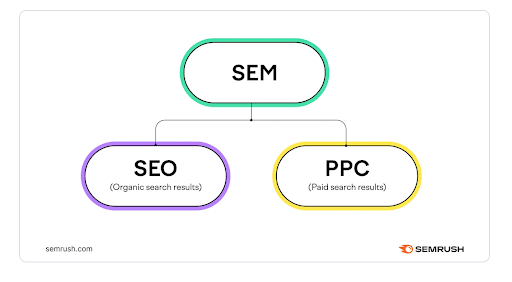
SEM includes both organic and paid search results
2. Search Engine Optimization (SEO)
SEO, or search engine optimization, is usually the first thing that comes to mind when discussing anything related to digital marketing. With most online businesses operating at the mercy of Google and other major search engines, SEO is the art of optimizing your content to ensure that your website is featured as a top result when relevant keywords are searched.
In fact, according to Search Engine Land, 53% of all website traffic is generated from organic search results.
When it comes to SEO, it’s not just all about your keywords. From technical SEO to on-site and off-site SEO, there are many ways that you can put the work in to boost your ranking.
A big part of SEO is your content. Quality, well-written, and beneficial content will always win over sloppy, inaccurate content – both for your reader and for the search engine crawlers.
Algorithms change, but people don’t. So, it’s also important to remember to build your site for your user, not for the SEO algorithm.
And don’t forget about those images! Jen Cornwell, the Vice President of SEO at Ignite Visibility, states that you should “Conduct an audit of your website’s images. Ensure they are compressed for faster loading times, include descriptive alt text, and have meaningful filenames. By taking these steps, you’ll improve user experience and enhance your SEO efforts simultaneously.”
3. Content Marketing
Content marketing is one of the broader digital marketing terms you might come across. With the ultimate goal of persuading your audience and building credibility, content marketing typically covers content assets like blog posts, infographics, e-books, videos, white papers, and webinars.

Various types of content marketing
However, it’s not just something for your audience to read. According to Allied Market Research’s 2024 report, it’s also a thriving industry, expected to reach $2 TRILLION by 2032.
Amber Gallegos, Director of Content states, “That’s a pretty huge industry and one you should jump into now if you haven’t already. Content marketing has the potential to propel your brand into levels you’ve never seen before.”
4. Paid Media
Pay-per-click (PPC) falls under the SEM umbrella when it applies to ads on search engine results pages, but it can also extend to affiliate marketing and ads on other websites.
You’ll find PPC marketing scattered throughout your online experience – on social media sites, on Google, on Bing, and in other places. You can notice them by the little “sponsored” label around it.

Example of Google PPC Ad
While Google Ads has a market share of 28%, making it the industry’s largest platform, PPC ads are also hugely popular on social media platforms like Facebook, Instagram, LinkedIn, and TikTok.
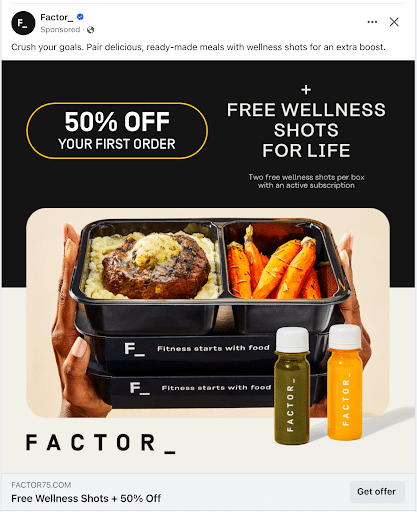
Example of Facebook PPC Ad
When following this type of model, you only pay for the number of clicks that you receive on your ad, making it an attractive option for businesses that have tighter budget constraints.
Meghan Parsons, Vice President of Paid Media, says, “The success lies in optimizing campaigns for platforms with the highest reported ROI rates, such as Facebook Ads and Google Ads.”
5. Email Marketing
Despite being one of the oldest types of digital marketing, email marketing is still one of the most reliable. In fact, over the last 12 months, 77% of marketers report having seen an increase in email marketing engagement.
It’s expected to reach almost $11 billion in revenue by the end of 2023 and is expected to continue to grow. Some experts expect it to hit almost $18 billion by 2027.
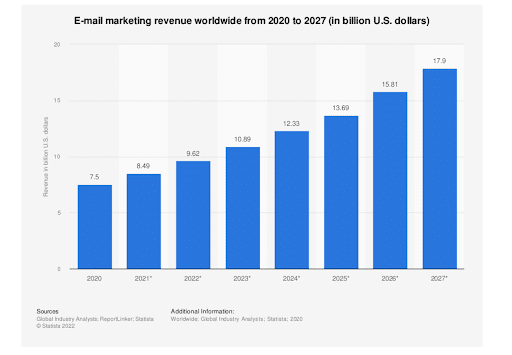
Email marketing is expected to hit $17.9 billion in revenue by 2017
Our Senior Director of Email Marketing, Emily Keye notes, “Email marketing stands as an indispensable pillar of success. There is so much importance that lies in crafting interesting content your audience gets excited to click on. No matter what industry you’re in, reaching your audience directly in their inbox can lead to immense amounts of success.”
Plus, the possibilities of the types of emails you can send are limitless. Choose from newsletter campaigns, confirmation emails, thank-you emails, follow-up emails, and email notifications about product updates.
6. Social Media Marketing (SMM)
Without a doubt, social media has become the ultimate game-changer in marketing over the last decade—one that brands cannot afford to overlook.
Thankfully, there are a variety of social media platforms you can choose from, including Facebook, Twitter, LinkedIn, Instagram, Snapchat, and many others. Depending on your niche and target audience, you can choose whichever one(s) is most relevant to your business.
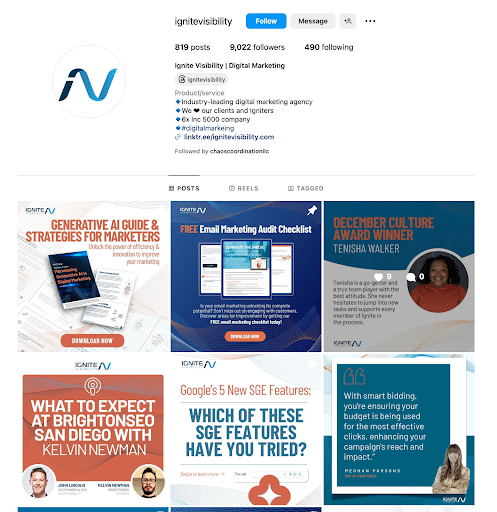
Ignite Visibility Social Media Account
There are a ton of platforms to choose from, including LinkedIn, Facebook, Instagram, TikTok, LinkedIn, Snapchat, X, Threads, and more. When it comes to social media, there truly is something for everyone. The key to finding success here is to find where your target audience is hanging out.
While some brands considered social media as a necessary line of communication for B2C audiences, Carl Bivona, Senior Director of Social Media Marketing, says that has changed. “Social media, known for its real-time connection and vast user base, has emerged as a critical marketing avenue for B2B interactions. A recent study shows that 84% of B2B marketers are turning to social media, specifically LinkedIn, making it the most commonly used B2B marketing tactic. It is bringing about a paradigm shift in how businesses converse, engage, and ultimately forge enduring relationships.”
7. Digital PR
Another form of digital marketing is digital PR. Similar to traditional PR, digital PR involves using online platforms and channels to create a brand reputation that you can be proud of.
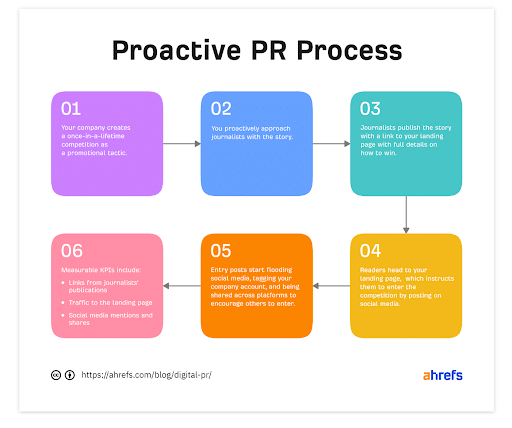
Follow a Proactive Digital PR Approach
As Morgan Dixon, our VP of Digital PR, says, “If you’re going to be online, you need to invest in a solid digital PR strategy. Your audience is online, and they’re going to see what people are saying about you and how you respond to it and use that to determine whether or not to trust your brand. And when it comes to making a purchase, trust between brand and consumer is key.”
Improving your digital PR strategy will take some work through various components like media outreach, press releases, linkable assets, online reputation management, and more.
8. Conversion Rate Optimization
Pushing traffic to your site is great, but it’s only half of the battle. Now that you’ve attracted their attention, how are you going to convert them? That’s where conversion rate optimization, or CRO, comes in.
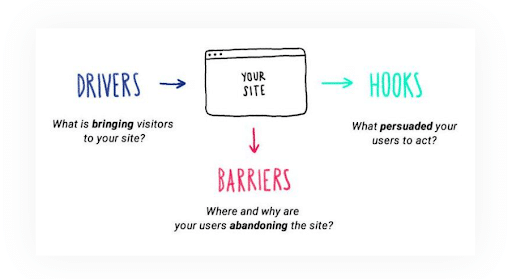
Definition of CRO
CRO has three unique aspects: acquisition, activation, and retention. When developing your strategy, you have to look at ways to attract your audience but also to activate and retain them. For this to happen, you have to dive deep into your audience data.
Our Director of CRO, Randy Anderson, says, “CRO, in its simplest form, is the art (and science) of optimizing your website visitors to perform a desired action. But holistically speaking, it’s so much more than that. CRO is about understanding your audience, tweaking your website, and continually testing to provide users with the best experience possible.”
9. Creative Marketing
Another aspect of digital marketing is your creative design services. To achieve true success in digital marketing, you have to create design elements that are creative, attractive, and cohesive.
What you post on social media should have the same general qualities as the content on your website and print ads. A cohesive and constant brand is key to generating brand awareness and turning all of your digital marketing attempts into brand loyalty and sales.
This goes far beyond a simple graphic. You have to think outside of the box. Many brands are finding success in designing creative video content.
As Oscar Lutteroth, our Chief Creative Officer, says, “With the rise of mobile internet usage and social media platforms favoring video content, neglecting video content is no longer an option for brands looking to thrive. Video marketing isn’t just about keeping up with trends; it’s about leveraging a powerful storytelling tool that can significantly amplify brand presence, enhance user engagement, and drive real business results.”
What is Digital Marketing? A Historical Overview
While it’s easy to remember a time before digital marketing, it’s hard to picture a world without it now.
While we can trace this groundbreaking form of consumer engagement all the way back to the late 1800s when Guglielmo Marconi invented the radio, there’s no denying that it has evolved since then.
In fact, digital marketing was reborn in 1971 when Ray Tomlinson sent the first-ever email. Regardless of whether Ray changed marketing as we know it, or if it was Philip Kotler, the American professor who has written more than 60 marketing books, the truth is digital marketing has changed the way retailers and consumers interact with each other.
The Evolution of Digital Marketing
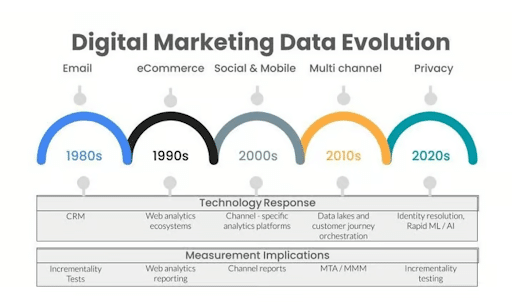
Digital Marketing Evolution
While marketing is evolving at a pace faster than ever before, the truth is that it has always been evolving. The progression of modern marketing can be broken up into the following stages:
The Production Era
With the birth of the Industrial Revolution, we also witnessed the rise of the Production Era. With the increase in machinery, it became more possible to mass produce products, which meant producers needed a way to market to a wider audience.
The Sales Orientation Era
The competition was the hallmark of this era. Following the Industrial Revolution, businesses were struggling to sell their mass-made products. As a result, branding and sales became important pillars as supplies surpassed demand and companies had to compete for customers.
The Marketing Orientation Era
From the second half of the 20th century onward, markets became heavily saturated, leading companies to give marketing professionals the opportunity to hone their skills on a more strategic level. These marketers would receive more of a say in what the company produced, its distribution channels, and its pricing strategy.
The Relationship Marketing Era
During this time, the focus of companies shifted towards customer loyalty and building a long-term relationship with consumers. Marketers were starting to realize that generic marketing campaigns, hard sell, and one-size-fits-all messaging were an outdated approach to earning a customer’s trust.
The Social Marketing Era
Originally meant to connect us to friends and family, social media completely changed the world of communication, including digital marketing. Thanks to social media giants companies can now interact with their audiences in real time with ease.
The Social Marketing Era also ushered in the birth of marketing automation. Now, you can automate almost everything from your social media marketing to your email marketing, with everything being tracked and monitored.
What’s Next?
With social media taking over so many aspects of our lives, we’re starting to see a new concern pop up – user privacy.
So far, this has led to a ban on third-party cookies. It’ll be interesting to see what other changes are made in the world of digital marketing as we move toward a safer internet experience for consumers.
Frequently Asked Questions About Digital Marketing
1. What is digital marketing?
Digital marketing refers to the use of the internet via mobile devices, social media, mobile devices, search engines, and other channels to market to consumers.
2. What is the role of digital marketing?
The role of digital marketing is to market to people looking for products and services related to your business by gaining leads, sales, new traffic and exposure, which is oftentimes done heavily online.
3. What is the next big thing in digital marketing?
The next big thing being talked about by many marketers is the power of AI in the forms of augmented reality and voice search systems. These innovations are already on the rise and are expected to be even more integrated into digital marketing.
4. Is digital marketing necessary for success?
The short answer – yes. However, what works for you might not work for another brand. It’s totally dependent on your audience, your industry, and your content. The best way to find success with digital marketing is to meet your audience where they are.
5. Is digital marketing another name for SEO?
No. SEO, or Search Engine Optimization, is a form of digital marketing. While SEO is very important to a solid digital marketing strategy, it is not the only aspect that makes it so powerful and successful.
Why Work with a Digital Marketing Partner?
Whether you’re looking to jump into paid ads, improve your email marketing open rate, or see more conversions from your organic traffic, Ignite Visibility can make it happen.
Our full-service digital marketing agency has everything you could need, including:
- Search Engine Optimization (SEO)
- Content Marketing
- Paid Media
- Email Marketing
- Social Media Marketing
- Digital PR
- Conversion Rate Optimization
- Creative Marketing
- And more!
Are you ready to experience what the power of a well-designed digital marketing campaign can do for you?
Schedule your free consultation now!
